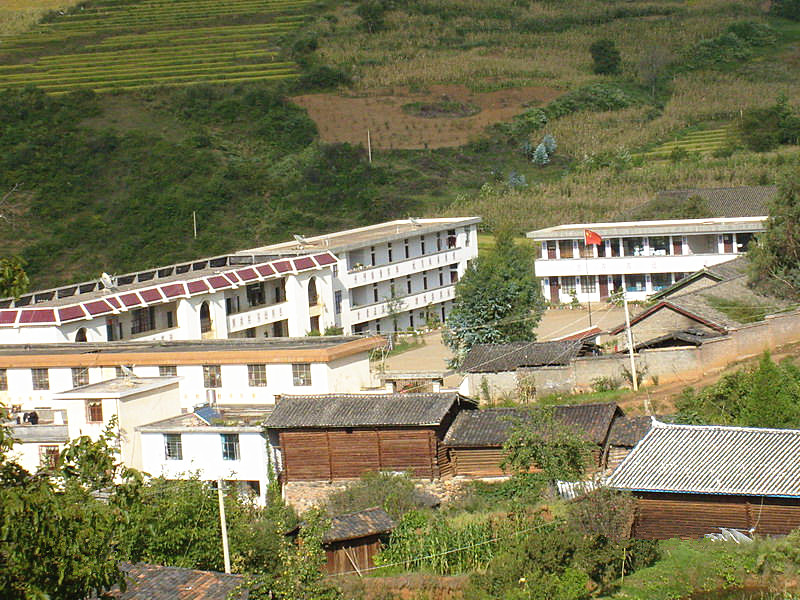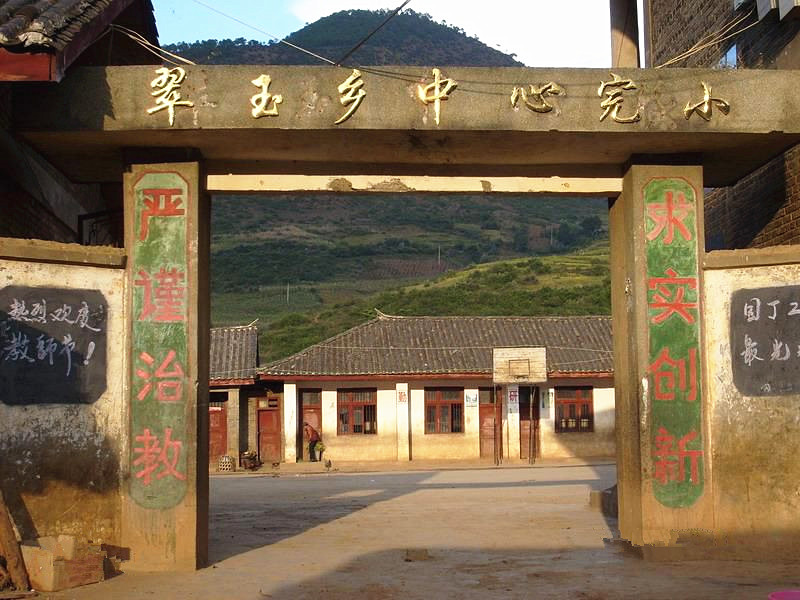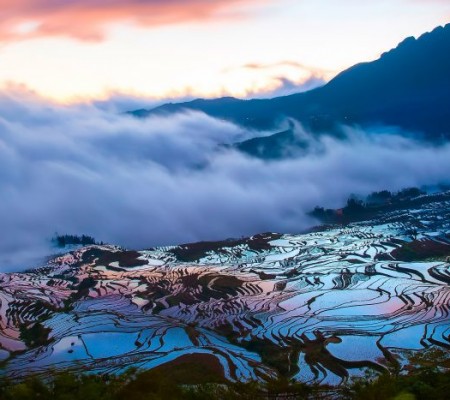Cuiyu Lisu and Pumi Ethnic Town of Ninglang County in Lijiang
Geographical Location
Cuiyu Lisu and Pumi Autonomous Township (翠玉傈僳族普米族自治乡) is located in the northwest of Ninglang Yi Autonomous County (宁蒗彝族自治县), Lijiang City (丽江市), Yunnan Province. It is 54 kilometers away from the county town of Ninglang. To the east, it borders Hongqiao Township (红桥乡); to the south, it connects with Tuojiao Village of Jinmian Township (金棉乡拖脚村); to the west, it faces Mingyin (鸣音) and Baoshan (宝山) of Lijiang County across the Jinsha River (金沙江); and to the north, it is separated from Yongning (永宁) and Laba (拉伯). The whole township is situated among continuous mountain ranges, with an average elevation of 2,240 meters. The annual average temperature is 13.4 degrees Celsius, and the annual rainfall is 900 millimeters. The area features high mountains and deep valleys, with significant elevation differences. The highest point is Baiyanzi (白岩子) of Shifo Mountain (石佛山), with an elevation of 4,510.3 meters, while the lowest point is Xiayanke Village (下岩科村) of Yidi Village Committee, with an elevation of 1,450 meters.
Ethnic Groups and Traditional Skills
Pumi Ethnic Group
Traditional Skills:
Four – Stringed Lute Making and Playing: The body of the four – stringed lute is carved with bear – paw patterns symbolizing ancestral totems. Elders can play the entire migration epic on it. Nowadays, the post – 00s intangible cultural heritage inheritor He Hao teaches the skill on Douyin, contributing to its inheritance.
Cuozuo Dance: A national intangible cultural heritage, called “cuozuo” in Pumi language, the dance is also known as “sheepskin dance,” “four – stringed dance,” or “Pumi Guozhuang.” It is said that there were originally 72 tunes, and now 12 sets are preserved. The dance retains the ancient characteristics of integrating song, dance, and music, with rich changes in formation and steps.
Cultural Heritage: Elders still use the ancient “Han Gu” script for divination. The pleated skirts of Pumi girls are unique, with folds resembling the wrinkles of mountains and rivers. The Pumi ethnic group has no written language of its own. Historically, in Muli and Ninglang areas, a simple pictographic script and “Han Gu” classics written in Tibetan letters were used for religious activities.
Lisu Ethnic Group
Traditional Skills:
Fireweed Cloth Weaving: In Peide Village (培德村), where Lisu people live in clusters, women pick fireweed around the Torch Festival on June 24th of the lunar calendar every year. They tear off the membrane on the back of fireweed leaves and twist it with hemp bark into threads. After more than 20 processes, the cloth is woven. This skill is included in the “Fourth Batch of National Intangible Cultural Heritage List.”
Log Cabin Construction: In Peide Village, log cabins are built with local materials, forming a typical Lisu residential style in western Yunnan. They are convenient to build and suitable for a nomadic lifestyle. Moreover, log cabins have the function of regulating temperature and humidity.
Customs and Festivals
Pumi Ethnic Group
Customs:
Life – Tree Custom: Planting a “life – tree” for a newborn baby symbolizes the vigorous growth of life and reflects the close connection with nature.
Marriage Customs: Girls wear star – studded capes during their coming – of – age ceremony. Pine needles are used to cover the wedding bed, symbolizing an evergreen marriage. The family’s fireplace burns 365 days a year, and the area around the fireplace is the center of family activities. Being able to grab the “upper eight seats” by the fireplace during meals is considered an honor for guests. Traditional delicacies include “pipa meat” (three – year – aged ham) and lacquer oil chicken (cooked with oil extracted from lacquer tree fruits).
Maternal Uncle’s Authority: The authority of the maternal uncle is equal to that of parents. Nephews and nieces visit their maternal uncles’ homes every year to celebrate the New Year. After a girl’s coming – of – age ceremony at 13, she must visit her maternal uncle, who will give her clothes, ornaments, or even livestock. When a married woman dies, her family must first inform her maternal uncle’s family.
Festivals:
Wuxi Festival: The Pumi New Year is the most important festival. In the Ninglang area, the first day of the twelfth lunar month is the beginning of the year, while in Lanping and Weixi, the Spring Festival is celebrated in the first month. During this period, activities such as ancestor worship, eating New Year’s Eve dinner, and coming – of – age ceremonies for 13 – year – olds are held. There are also mountain hunting, mountain grazing, playing on swings, mountain god worship, and Guozhuang dancing.
Big Fifteenth Festival: On the fourteenth day of the twelfth lunar month in the Ninglang area, people dress in bright new clothes and go camping in the mountains. They hold bonfire parties. The next day, they walk around the “Mani pile” to pray for blessings. Young men and women take this opportunity to sing, dance, and socialize.
Snow Threshold Mountain – Climbing Festival: On the fifth day of the fifth lunar month, it is a traditional festival of the Pumi people in Lanping. People carry four – stringed lutes, bring yellow wine and meat, and go to the snowy threshold mountain top meadow to celebrate. The sick go up the mountain to collect medicinal herbs, and the young sing love songs to each other. There are also activities such as archery and wrestling. The climax is the sheepskin dance.
Mountain – Turning Festival: On the fifteenth day of the seventh lunar month, people worship the mountain god. Pumi men and women of all ages go to the designated mountain head in groups and participate in various traditional activities.
Lisu Ethnic Group
Customs: Villages are close to each other, with visible cooking smoke and audible roosters and dogs. The diet is mainly corn, supplemented by rice, wheat, and so on. People have a preference for tea and alcohol. The water wine, similar to beer, is loved by men and women of all ages and is a must – have for entertaining guests. There is a saying “no wine, no talk.”
Festivals:
Kuoshijie Festival: The most important traditional festival of the Lisu ethnic group, equivalent to the Han Chinese New Year. In the past, different villages celebrated at different times, between December 5th of the lunar calendar and January 10th of the following year, during the blooming of cherry blossoms. In 1992, the Lijiang Regional People’s Congress Standing Committee passed a resolution to set December 20th as the Kuoshijie Festival for the Lisu people in the city.
Ancient Architecture
Pumi Log Cabin
The Pumi log cabin is a pure wooden structure, locally called “mu lei zi.” Each household’s residence surrounds a courtyard. The main house is rectangular or square, with four corners having pillars and a central “supporting sky pillar,” which is considered the residence of the deity. Inside the main house, there is a fireplace (pot stove), which is the center of family activities. People eat, sleep, discuss matters, and entertain guests here. The wing rooms and gate towers are mostly two – storied. The upper floor is for living, while the lower floor is for keeping livestock or storing miscellaneous items. There are no windows inside, and light and ventilation are achieved by lifting two sliding panels on the roof. Outside the main gate, animal skulls are hung to ward off evil spirits and pray for the prosperity of livestock. Inside the house, pig lower skeletons are hung to symbolize wealth, and pig bladders are hung to prevent fires.
Lisu Log Cabin (Taking Peide Village as an Example)
The log cabins in Peide Village are built with local materials, forming a unique residential style of the Lisu people in western Yunnan. The houses are built with logs painted with red lime. The streets and alleys are simple and winding. The central street runs from north to south and is the lifeline of the village. The living alleys on both sides are narrow, paved with broken stones, and bordered by cacti as green fences, creating a unique street and alley space and landscape.
Historical Figures
According to legend, the ancient leader of the Pumi ethnic group was the White Wolf King, who ruled the White Wolf Kingdom during the Eastern Han Dynasty and presented the “White Wolf Song” to the Han Dynasty court. Some old people in the village can still sing the related ancient songs today.
Tourist Attractions
Natural Scenery
Alpine Meadows and Primeval Forests: There are vast alpine meadows such as the Qingren Dam in Luoguqing, surrounded by primeval forests. The dark green moss in the fir forest and the blooming alpine azaleas in April make it a breathtaking sight. Walking through it, you can encounter ferns, lichens, fungi, and various animals and insects such as squirrels.
Diverse Hiking Trails:
Easy Hiking (5km): Starting from Qingren Dam, passing through Huaxigou and Hua Ping Mountain, and arriving at Mother Tree, you can enjoy the meadow cattle and sheep and the primeval forest along the way.
Medium Hiking (14km): Based on the easy hiking, you can also encounter alpine Danxia landforms. The route is Qingren Dam – Mother Tree – Jiliji Viewing Platform – Golden Cicada Gazing at the Moon – Wind – Listening Cliff – Qian Gui Mountain.
Full – Length Hiking (24km): Starting from Dayang Field, passing through Xiaoyang Field, Ye Xiang Valley, Kalabu Danxia, Bai Zhang Echo, Qian Gui Mountain, and finally arriving at Qingren Dam, you can enjoy a wealth of natural scenery.
Pasture Scenery: Qingren Dam is an important grazing area in the village, where cattle, sheep, horses, and piglets can be seen everywhere. Visitors can bring their children to experience being a little shepherd for a day.
Cultural Attractions
Pumi Ancient Village: It has preserved the thousand – year – old traditions. There are only about a hundred households of indigenous people, with simple and honest folk customs. Visitors can explore the living environment of the Pumi people, learn the Pumi language, and understand Pumi culture and ethnic stories.
Folklore Experience: Experience Pumi costumes, participate in Pumi family banquets, and taste special delicacies. At night, dance the Cuozuo dance around the bonfire with villagers to feel the ethnic charm.
Intangible Cultural Heritage Display: You can enjoy the performance of Pumi four – stringed lute playing and Cuozuo dance, and watch the display of Lisu fireweed cloth weaving and other intangible cultural heritage skills to deeply understand the charm of ethnic minority cultures.
Transportation
External Transportation
By Air or Train: First, arrive in Dali or Lijiang. Both Dali and Lijiang have convenient transportation with airports and railway stations. You can take flights or trains from all over the country.
Renting a Car for Self – driving: Rent a car in Dali or Lijiang and navigate to “Ninglang County Cuiyu Lisu and Pumi Autonomous Township” or specific attractions (such as Luoguqing Scenic Area). The drive takes about 2.5 – 3 hours. Self – driving allows you to freely arrange your itinerary and stop at any time to enjoy the scenery along the way.
Car – pooling: Find car – pooling information through local tourism service platforms or guesthouses. Car – pooling is relatively cheaper than renting a car, and having company to chat with can make the journey more enjoyable.
Internal Transportation
After arriving in the township, some attractions are close enough to walk to, allowing you to deeply experience the local scenery. In some areas, there may be unique means of transportation such as horse – drawn carriages, which you can take to enjoy a different travel experience. When going to some remote attractions without public transportation, you can consult local villagers or guesthouse owners to find suitable transportation.



 7 Days GolfingTour
7 Days GolfingTour
 8 Days Group Tour
8 Days Group Tour
 8 Days Yunnan Tour
8 Days Yunnan Tour
 7 Days Shangri La Hiking
7 Days Shangri La Hiking
 11 Days Yunnan Tour
11 Days Yunnan Tour
 6 Days Yuanyang Terraces
6 Days Yuanyang Terraces
 11 Days Yunnan Tour
11 Days Yunnan Tour
 8 Days South Yunnan
8 Days South Yunnan
 7 Days Tea Tour
7 Days Tea Tour
 8 Days Muslim Tour
8 Days Muslim Tour
 12 Days Self-Driving
12 Days Self-Driving
 4 Days Haba Climbing
4 Days Haba Climbing
 Tiger Leaping Gorge
Tiger Leaping Gorge
 Stone Forest
Stone Forest
 Yunnan-Tibet
Yunnan-Tibet
 Hani Rice Terraces
Hani Rice Terraces
 Kunming
Kunming
 Lijiang
Lijiang
 Shangri-la
Shangri-la
 Dali
Dali
 XishuangBanna
XishuangBanna
 Honghe
Honghe
 Kunming
Kunming
 Lijiang
Lijiang
 Shangri-la
Shangri-la
 Yuanyang Rice Terraces
Yuanyang Rice Terraces
 Nujiang
Nujiang
 XishuangBanna
XishuangBanna
 Spring City Golf
Spring City Golf
 Snow Mountain Golf
Snow Mountain Golf
 Stone Mountain Golf
Stone Mountain Golf
















